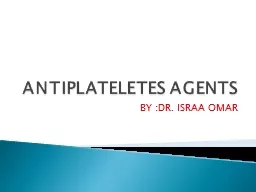

Platelets play a critical role in thromboembolic disease like ischemic heart disease and stroke Platelets adhere to the diseased or damaged areas and become activated exposing phospholipids and GPIIbIIIa ID: 908990
Download Presentation The PPT/PDF document "ANTIPLATELETES AGENTS BY :DR. ISRAA OMA..." is the property of its rightful owner. Permission is granted to download and print the materials on this web site for personal, non-commercial use only, and to display it on your personal computer provided you do not modify the materials and that you retain all copyright notices contained in the materials. By downloading content from our website, you accept the terms of this agreement.
Slide1
ANTIPLATELETES AGENTS
BY :DR. ISRAA OMAR
Slide2Platelets play a critical role in thromboembolic disease like ischemic heart disease and stroke
Platelets adhere to the diseased or damaged areas and become activated , exposing phospholipids and
GPIIb/IIIa receptors.Platelet change their shape to stellate formActivate platelets also synthesize and release mediators like TXA2 and ADP, which stimulate other platelets to aggregate and eventually fibrin formation and thrombosis.Platelet aggregation is inhibited by prostaglandin I2TXA2 production is reduced by cAMP
The role of platelets
Slide3Aspirin inhibits COX-1 irreversibly, this will lead to inhibition of synthesis of thromboxane A2 which in turn lead to inhibition of platelet activation and aggregation.
Aspirin(
Acetylsalicylic acid )
Slide4Aspirin
(
Acetylsalicylic acid) – mechanism of action
Slide5Acetylsalicylic acid – (
Aspirin)
mechanism of action
Slide6(
Acetylsalicylic acid – (
Aspirinmechanism of action
Slide7(Aspirin )
Acetylsalicylic acid –
mechanism of action
Slide8(Aspirin)
Acetylsalicylic acid –
mechanism of action
Slide9Rapid absorption of aspirin occurs in the stomach and upper intestine, with the peak plasma concentration being achieved 15-20 minutes after administration
The peak inhibitory effect on platelet aggregation is apparent approximately one hour post-administration
Aspirin produces the irreversible inhibition of the enzyme cyclooxygenase and therefore causes irreversible inhibition of platelets for the rest of their lifespan (7 days)Acetylsalicylic acid (aspirin)– pharmacokinetics
Slide10Secondary prevention of transient ischaemic attack (TIA), ischaemic stroke and myocardial infarction
Prevention of ischaemic events in patients with angina pectoris
Prevention of coronary artery bypass graft (CABG) occlusionAcetylsalicylic acid – major use
Slide11Risk of gastrointestinal adverse events (ulceration and bleeding)
Allergic reactions
Is not a very effective antithrombotic drug but is widely used because of its ease of useLack of response in some patients (aspirin resistance)The irreversible platelet inhibition(Aspirin )
Acetylsalicylic acid – major drawbacks
Slide12It inhibits platelets aggregation by irreversibly binding for ADP receptors on the surface of platelets.
This will lead to reduce mobilization of calcium from intracellular stores and reduces the expression of glycoprotein receptors on the platelets surface
Clopidogrel and Ticlodipine (Thienopyridines )
Slide13ADP-receptor antagonists
–
mechanism of action
Slide14ADP-receptor antagonists – mechanism of action
Slide15ADP-receptor antagonists – mechanism of action
Slide16ADP-receptor antagonists – mechanism of action
Slide17Both currently available ADP-receptor antagonists are thienopyridines that can be administered orally, and absorption is approximately 80-90%
Thienopyridines are pro-drugs that must be activated in the liver
ADP-receptor antagonists – pharmacokinetics
Slide18Secondary prevention of ischaemic complications after myocardial infarction, ischaemic stroke and established peripheral arterial disease
Secondary prevention of ischaemic complications in patients with acute coronary syndrome (ACS) without ST-segment elevation
ADP-receptor antagonists – major use
Slide19Clopidogrel is only slightly more effective than aspirin
As with aspirin, clopidogrel binds irreversibly to platelets
In some patients there is resistance to clopidogrel treatmentADP-receptor antagonists – major drawbacks
Slide20Abciximab is a monoclonal antibody with Fc region removed to prevent immunogenicity .
It bind irreversibly to
GPIIb/IIIa receptors and prevent its binding to fibrinogen .It can reduce the platelets aggregation by more than 90% .GPIIb/IIIa-receptor antagonists
Slide21Antibody
Slide22GPIIb/IIIa-receptor antagonists –
mechanism of action
Slide23GPIIb/IIIa-receptor antagonists –
mechanism of action
Slide24GPIIb/IIIa-receptor antagonists –
mechanism of action
Slide25GPIIb/IIIa-receptor antagonists –
mechanism of action
Slide26GPIIb/IIIa-receptor antagonists –
mechanism of action
Slide27Prevention of ischaemic cardiac complications in patients with acute coronary syndrome (ACS) without ST-elevation and during percutaneous coronary interventions (PCI), in combination with aspirin and heparin
GPIIb/IIIa-receptor antagonists
– major use
Slide28It is a phosphodiaestrase inhibitor .
It increases intracellular cyclic AMP ,thus reducing TXA2 synthesizes and also potentiate the prostacyclin effect on platelets making them less sticky and therefore making them less adhesive to thrombogenic surface .
It is ineffective when used alone ;should be used with aspirin it reduces the risk of stroke .Unlike aspirin it does not increase the risk of bleeding Dipyramole
Slide29Thank you
Slide30Lippincottes pharmacology
Rang and dale pharmacology
Referrences: